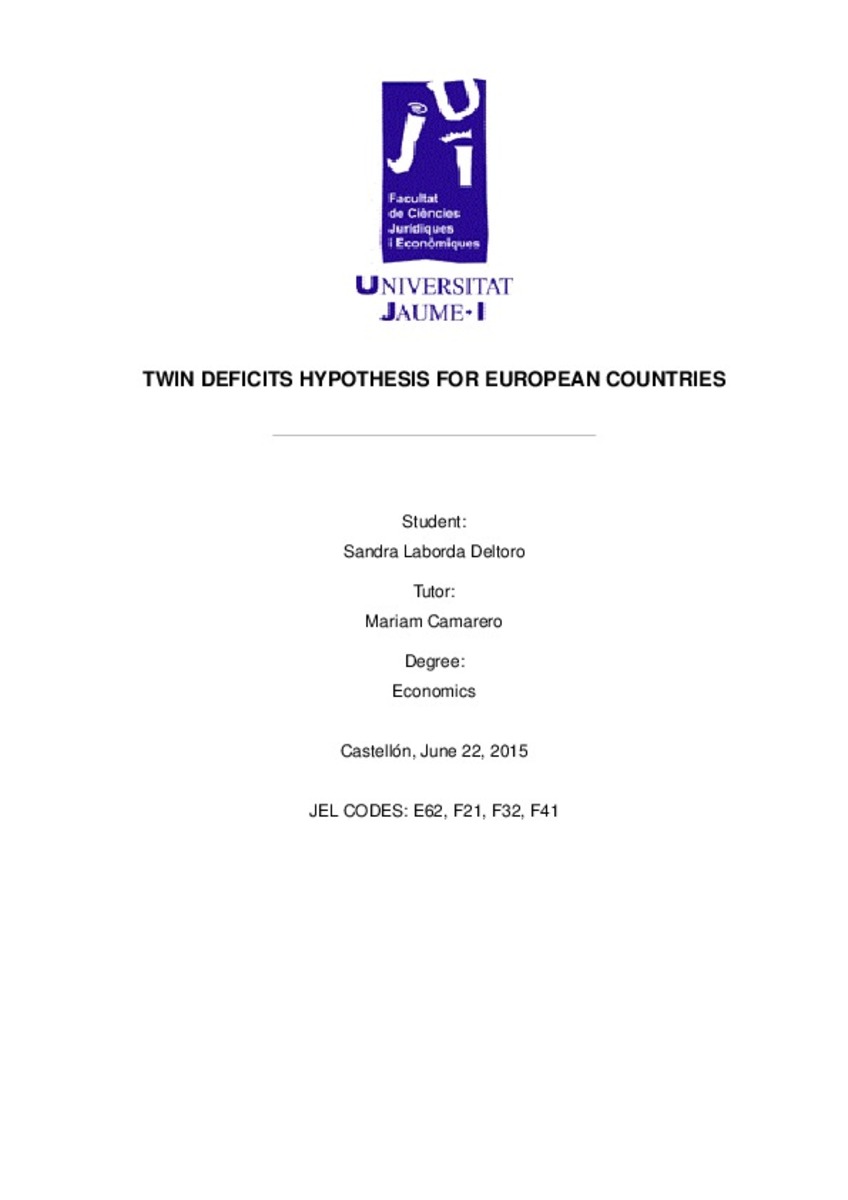Mostrar el registro sencillo del ítem
Twin deficits hypothesis for European countries
| dc.contributor | Camarero, Mariam | |
| dc.contributor.author | Laborda Deltoro, Sandra | |
| dc.contributor.other | Universitat Jaume I. Departament d'Economia | |
| dc.date.accessioned | 2015-09-07T11:48:15Z | |
| dc.date.available | 2015-09-07T11:48:15Z | |
| dc.date.issued | 2015 | |
| dc.identifier.uri | http://hdl.handle.net/10234/131408 | |
| dc.description | Treball Final de Grau en Economia. Codi: EC1049. Curs: 2014/2015 | ca_CA |
| dc.description.abstract | Recently, several European economies have suffered a deterioration in their fiscal and current account imbalances. The global crisis has contributed to possible linkages between fiscal and current account deficits. These linkages are known as ”The Twin Deficit Hypothesis”. The case of several European economies is that, excessive deficits lead into insolvency which reflects inability of the government to stabilize its public debit ratio and to pay its debts. The twin deficit hypothesis states that an increase in the fiscal deficit causes an increase in the current account deficit. Our argument starts from the observation that, by national accounting, a fall in national savings because of a government deficit translates into a fall in the current account balance. On the other hand, private savings will increase in response to fiscal shocks increasing public debt, as a higher debt generates expectations of higher taxes in the future. According to the Mundell-Fleming model, with flexible exchange rates, fiscal deficits appreciate the currency: an increase in the relative price of domestic goods crowds out net export. If fiscal deficits also raise the interest rate, the external imbalance may be moderated by a simultaneous fall in domestic investment. This model emphasised changes in terms of trade and interest rates, but abstracts from inter-temporal consumption and treats the rate of return to investment as exogenous. Conversely, models following the so-called inter-temporal approach to the current account emphasize consumption and optimal intertemporal investment decisions, but typically postulate a high degree of world market integration. The objective of this paper is to provide a deeper insight on the dynamic linkages between the twin deficits by testing 10 European countries: Austria, Finland, France, Germany, Greece, Ireland, Italy, Netherlands, Portugal and Spain. An approach based on the Granger causality test was used, and the period analysed is from 1970 to 2011. The study examines diversity across a selected group of countries with weak economic situations. The causal relationship could not be stable because of the current global crisis, so in presence of instability the result could suggest erroneous or unproductive. This paper is organized as follows. In Chapter 2 ”Theoretical Basis” a short discussion of the behaviour of the budget balance and the current account balance is provided, Chapter 3 reviews the literature on the linkages between external and internal deficits, and exposes the different conclusions reached by the authors; Chapter 4 discusses the empirical methodologies employed in the econometric analysis, Chapter 5 contains the description and the empirical analysis of the data. Finally, the conclusions are included in the sixth chapter. | ca_CA |
| dc.format.mimetype | application/pdf | ca_CA |
| dc.language.iso | eng | ca_CA |
| dc.publisher | Universitat Jaume I | ca_CA |
| dc.rights | Attribution-NonCommercial-ShareAlike 4.0 Spain | * |
| dc.rights.uri | http://creativecommons.org/licenses/by-nc-sa/4.0/ | * |
| dc.subject | Grau en Economia | ca_CA |
| dc.subject | Grado en Economía | ca_CA |
| dc.subject | Bachelor's Degree in Economics | ca_CA |
| dc.subject | Déficit económico | ca_CA |
| dc.subject | Déficit presupuestario | ca_CA |
| dc.subject.other | Dèficits pressupostaris | ca_CA |
| dc.title | Twin deficits hypothesis for European countries | ca_CA |
| dc.type | info:eu-repo/semantics/bachelorThesis | ca_CA |
| dc.educationLevel | Estudios de Grado | ca_CA |
| dc.rights.accessRights | info:eu-repo/semantics/openAccess | ca_CA |
Ficheros en el ítem
Este ítem aparece en la(s) siguiente(s) colección(ones)
-
Grau en Economia [289]
EC1049








